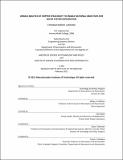| dc.contributor.advisor | Jeffrey A. Hoffman and John Danis. | en_US |
| dc.contributor.author | Lanford, Ephraim Robert | en_US |
| dc.contributor.other | Massachusetts Institute of Technology. Dept. of Aeronautics and Astronautics. | en_US |
| dc.date.accessioned | 2011-05-23T15:32:53Z | |
| dc.date.available | 2011-05-23T15:32:53Z | |
| dc.date.copyright | 2011 | en_US |
| dc.date.issued | 2011 | en_US |
| dc.identifier.uri | http://hdl.handle.net/1721.1/62889 | |
| dc.description | Thesis (S.M. in Technology and Policy)--Massachusetts Institute of Technology, Engineering Systems Division, Technology and Policy Program; and, (S.M.)--Massachusetts Institute of Technology, Dept. of Aeronautics and Astronautics, 2011. | en_US |
| dc.description | This electronic version was submitted by the student author. The certified thesis is available in the Institute Archives and Special Collections. | en_US |
| dc.description | Cataloged from student submitted PDF version of thesis. | en_US |
| dc.description | Includes bibliographical references (p. 126-136). | en_US |
| dc.description.abstract | In comparison with conventional and other conceived approaches, hopper spacecraft offer unique advantages in exploring Solar System objects beyond Earth. The present work began with a survey - based on documents from the White House, Congress, NASA, and the international planetary science community - of exploration plans and objectives in the United States. The results are presented, and lead into a representative description of goals that might be enabled by hoppers. Relevant hopper attributes are then described in comparison to other vehicle types, and these vehicle characteristics are mapped to the exploration goals to show how hoppers can facilitate achievement of policy and science objectives. Specific examples are examined by formulating and analyzing a demonstrative and timely variety of model missions on Earth's Moon, Mars, and Saturn's moon Titan. These analyses use models for both hovering and ballistic hops to produce realistic values for hopper performance including mass, fuel consumption, trajectory characteristics, and basic spacecraft subsystem characteristics. In sum, planetary hopper technology is not for every mission, but generally offers paradigm-changing mobility and flexibility for small additional mass or development costs. Mission planners should evaluate hoppers for suitability to their exploration goals. Policy recommendations are offered toward this purpose. | en_US |
| dc.description.statementofresponsibility | by Ephraim Robert Lanford. | en_US |
| dc.format.extent | 136 p. | en_US |
| dc.language.iso | eng | en_US |
| dc.publisher | Massachusetts Institute of Technology | en_US |
| dc.rights | M.I.T. theses are protected by
copyright. They may be viewed from this source for any purpose, but
reproduction or distribution in any format is prohibited without written
permission. See provided URL for inquiries about permission. | en_US |
| dc.rights.uri | http://dspace.mit.edu/handle/1721.1/7582 | en_US |
| dc.subject | Engineering Systems Division. | en_US |
| dc.subject | Technology and Policy Program. | en_US |
| dc.subject | Aeronautics and Astronautics. | en_US |
| dc.title | Unique abilities of hopper spacecraft to enable national objectives for solar system exploration | en_US |
| dc.type | Thesis | en_US |
| dc.description.degree | S.M. | en_US |
| dc.description.degree | S.M.in Technology and Policy | en_US |
| dc.contributor.department | Massachusetts Institute of Technology. Department of Aeronautics and Astronautics | |
| dc.contributor.department | Massachusetts Institute of Technology. Engineering Systems Division | |
| dc.identifier.oclc | 725945386 | en_US |
